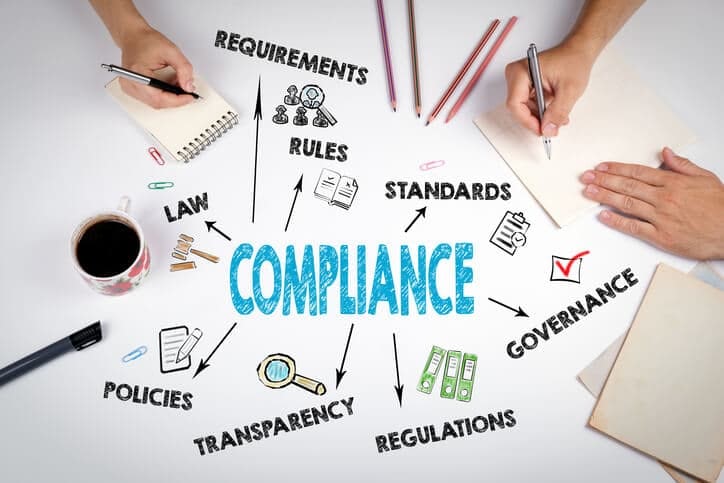付加価値税とは ?
付加価値税やVATは、少し複雑に聞こえることがありますが、それを分解すると、政府などの税務当局がメーカーの経済チェーンの各ステップで付加価値の割合を収集するプロセスとして説明できます。 最終的に、VATプロセスは消費者による商品またはサービスの消費で終了します。
グローバルVATプロセスには、サプライヤー、バイヤー、税務当局(政府)という3つの主要プレーヤーが関与しています。 VAT料金は、このチェーンのすべての当事者によって支払われますが、企業のみが入力税を控除できます。

VATは世界経済に大きな影響を与え、世界で最も重要な 消費税制度です。 162 貿易国では、 VATはすべての公共収入 の 30tを超える貢献をしています。

政府は年に初めて導入されて以来、世界中でVATを使用していますが1950s、企業が知っておくべき重要なグローバルVAT変更が現在行われています。 これらの大きな変更の1つは、グローバルなVATギャップの拡大とCTCの導入(継続的な取引管理)です。
VAT コンプライアンスの ギャップとCTC の導入
世界中で、企業はVATを正しく処理し、報告する責任があります。 これを正しく行えば、税務当局はグローバルなビジネス取引を監査し、管理することができます。 しかし、政府がこのような監査を実施しているにもかかわらず、詐欺、不正行為、人為的ミスは政府がすべきよりも大幅に少ないVATを徴収する原因となります。
世界的に見ると、VATギャップは15000億ユーロ以上に拡大しており、これは世界中で徴収すべきVATの約15~30%に相当します。
VAT格差の拡大の結果、世界各国の 政府は、新しい規則や規制、罰則を導入しました。
VAT 不遵守 の上位8 の結果
VATギャップの拡大を減らすため、税務当局はさまざまな種類の法的罰則と規制を施行しています。 VATの不遵守は、一部の国では重大な刑事犯罪です。そのため、企業は、これらの8つの結果に直面することになるため、グローバルVATコンプライアンスを迅速かつ容易に証明できることを確認する必要があります。

CTC と VAT コンプライアンス 規制 の比較を 詳しく 見る
前述したように、CTCの遵守を証明することができない企業は、VAT違反で有罪判決を受けた企業よりも重い罰則が科される見込みです。 その主な理由の1つは、その名前が示すように、税務当局がCTCを使用して、英国のように3か月ごとではなく、継続的に会社の取引を制御することです。
最近のメキシコの法律は、政府がCTC規制を適用した例です。 この法律は、存在しない業務に対する請求を重罪とし、税詐欺または組織犯罪として分類することができます。
グローバルCTCへのコンプライアンスを維持するには、厳格なコンプライアンス変更管理に依存する6つの法的要件を企業が特定することが非常に重要です。

世界中のCTCおよびVATコンプライアンスのトレンド
事業を グローバルに拡大することを計画 している企業は、EMEA、AMER、 APAC地域の VATとCTC のトレンド に 慣れ る必要があります。
1. ヨーロッパ、中東、アフリカ(EMEA)におけるVATコンプライアンスとCTC
EMEA全域の政府は、EUレベルと加盟国の3つの主要な法律(VAT指令、EU 5 VAT指令修正指令、EU指令)が収束した結果、CTCの使用が増え始めています。 注意すべき新しい更新には、以下が含まれます。
- EU全体でCTCを採用する主な理由の1つは、既存のVAT報告プロセスをより詳細かつ頻繁に行うことです。 要するに、これはCTCがすべてであり、企業は従来のより頻度の低いVAT申告ではなく、継続的にVAT遵守を証明することができます。
- 電子請求書もこの地域で広く受け入れられています。 英国、ポーランド、スペイン、ハンガリーなどの国々は、新しいVAT要件を最初に導入しました。 これらの新しい規則では、企業はデジタルファイル(電子請求)に、より詳細なトランザクションデータを提出する必要があります。 これは、ほとんどの企業が慣れている、VAT提出の頻度を減らすためのものです。
- しかし、現在、イタリアは、本格的な必須のCTC電子請求書が整備されている唯一のヨーロッパの国です。 他のEU諸国では、CTCの電子請求書発行のみが選択肢となっています。
2. 米州におけるVATコンプライアンスおよびCTC(AMER)
- VAT記録手続きは、米国(米国、カナダ、メキシコ、南米)の企業とEUの企業では大きく異なります。 カナダ、北米、南米の政府は現在、請求書作成プロセスではなく、正確な記録保持慣行に重点を置いています。 しかし、グローバルなトレンドが反対方向に急激に動き始め、税務当局が請求書作成プロセスの再考に焦点を当てているため、これはAMERでは徐々に変化しています。CTC電子請求書の導入がその一例です。
- AMERの企業は、南北アメリカの税務当局間の結束した協力関係が著しく増加しているため、今日、自社のシステムをCTC電子請求に適応させる必要があります。 例えば、脱税と詐欺と闘うために、メキシコ税務当局(SAT)は最近、標準化されたメキシコの電子請求書プロセスの延長を実施しました。 税務当局は、メキシコから米国およびカナダへの輸出取引に関与する企業に対して、この新しいプロセスを導入しました。
- さらに、ラテンアメリカ(南米、中米、カリブ海諸島、メキシコ)でのVAT不遵守は選択肢ではありません。 電子請求書のコンプライアンスはむしろ二元的な提案であり、コンプライアンスに準拠した請求書が発行されるか、受領されるか、またはどちらも行われません。 非準拠の請求書の発行または受領の結果は、中南米では他のどのAMER地域よりもはるかに厳格です。 例えば、VATの不遵守に対する行政上の罰則は、場合によっては実際の取引額を超える可能性があります。ブラジルでは、罰金は取引額の最大150パーセントになる可能性があります。
3. アジア太平洋地域(APAC)におけるVATコンプライアンスとCTC
- APAC地域の政府は、電子請求書発行の分野で先駆者になっています。 CTCに対する中南米の厳しい制限の影響とインスピレーションを受け、中国、インドネシア、台湾などの国々は今後数年以内に一部または完全な電子請求書発行を義務付けています。
- 中国での電子VAT請求は約20年前に始まり、当時は金税制と呼ばれていた。 これは、報告および請求のための課税プラットフォーム、ならびに電子署名に関する法規制および合法性で構成されていた。 現在、APACの企業は、税務当局によって認定されたソフトウェアを使用して、国内システムを介して請求書を発行できます。
- APAC地域の政府は、電子請求書発行に関する明確な基準の設定にも取り組んでいます。 これには、企業のデータ交換基準とともに、セキュリティおよび運用要件を明確に定義することが含まれます。 特にアジアの企業は、これらの基準を使い始めています。
グローバルVATコンプライアンスの未来におけるテクノロジーの役割
CTCは、ビジネスをグローバル市場に進出させようとしている企業にとって、未来になりつつあります。 なぜでしょうか? 電子請求書により、国際市場で取引を行う企業は、サプライヤーとの取引をリアルタイムで送信して記録することができます。 以来のIT技術の開発1950sは、この進歩の重要な要素となっています。
さらに、PwCの最近の調査によると、企業がVATを支払い、オンラインで申告する国では、VAT義務を遵守するのに平均27して%の時間がかかります。 年以来2008、以上の26国々が電子申告・支払システムを採用しています。 テクノロジーとCTCの電子請求書発行は、グローバル企業がビジネス手続きをより効率的にするだけでなく、不正行為や回避を減らすための道を切り開いています。
貴社はリモートチームの構築を検討していますか? 当社のフルスタックGlobal Employment Platformと人事専門家は、グローバルVATコンプライアンスのプロセスを簡単に、迅速に管理することを支援します。 今すぐお問い合わせください。










